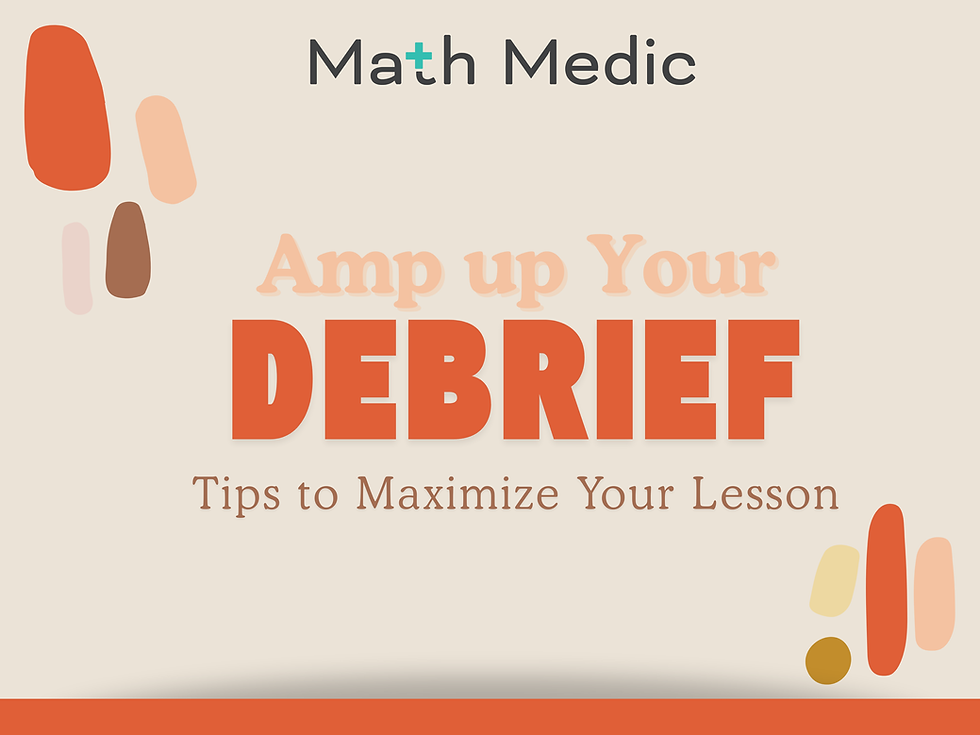What Does It Mean to "Use Appropriate Tools Strategically"?
- Sarah Stecher

- Mar 24
- 3 min read
If there’s a favorite phrase of teachers, it might be “use your resources”. Encouraging students to take advantage of what they have available to them, whether that’s yesterday’s notes, a graphing calculator, or the help of a peer is a strategy for helping students become autonomous learners. Understanding what tools are available and selecting the appropriate one to achieve the desired goal is inherent in doing mathematics. For this reason, the skill of “using appropriate tools strategically” is identified as one of the 8 mathematical practices by the Common Core.
What are “Tools”?
Tools can be thought of in broad terms, but here we will focus on tools available to students in the math classroom. These could be physical tools, such as protractors, manipulatives, or compasses, or technological tools, such as graphing calculators or statistical applets. The purpose of the tool is to help students visualize, concretize, or conceptualize. In essence, to deepen understanding or aid in problem solving.

But the ability to “use appropriate tools strategically” encompasses much more than just knowing how to use the resource. Yes, we need to teach students how to use a protractor, or remember the sequence of keys to finding numerical derivatives, but we also need to teach students how to decide when a certain tool is necessary or helpful. Additionally, students need to learn if the answer obtained from using their tool is reasonable.
How do we do this?
Make tools readily available. In our classrooms, we like to have a variety of materials available either on their tables or in a designated part of the classroom. This includes colored pencils, scratch paper, graph paper, protractors, rulers, string, counters, and algebra tiles. We tell students at the beginning of the year that these resources are available for whenever they need them and they are welcome to use them without asking if they find them helpful on a task. Be aware that there is some stigma (especially in high school) around using physical manipulatives, so it is important to normalize the use of tools like this. Solving a quadratic on paper or in one’s head is not superior to visually completing the square with algebra tiles! In fact, being able to represent one’s thinking and make something abstract concrete is one way of being mathematical. This is one benefit of putting materials on students’ tables, so an individual doesn’t have to walk in front of the class to gather a tool.
Ask questions that support the use of tools. Helping students be metacognitive about their mathematical processes and problem solving strategies is an important aspect of honing these skills. To do this, consider asking questions like:
Are there tools you could use that could help you solve this?
Why did you decide to use that tool?
Which tool do you think would be most helpful?
How will you know if your answer is reasonable?
Have you solved a problem like this before? What helped you?
Emphasize the power of estimation. While helping students learn to choose and use tools is certainly valuable, we want to avoid an overreliance on tools or a blind use of tools. Students should always consider whether the answer they got using the tool is reasonable. Should this angle really be less than 90˚? Does it make sense to get a negative answer here? Is 8 centimeters reasonable for the length of an eraser? Does the value predicted by this regression equation make sense in light of the other data points? Jo Boaler, professor at Stanford’s Graduate School of Education, suggests in her new book Math-ish that teachers should encourage students to find “ish” answers before engaging in formal calculations and procedures. “Ish” answers are rough estimates based on context, number sense, and a conceptual understanding of the items being manipulated.
Considering the available tools and choosing among them, as well as evaluating the output of the tool, is more important now than ever before. Students have easy access to thousands of tools through their phones and computers, and it is worthwhile considering how we implement these in sound ways both inside and outside the classroom. Introducing students to helpful online tools (ex: Desmos, Stapplet, NumWorks, Geogebra, Mathigon, etc.) can aid students in visualizing and making sense of mathematical ideas. Additionally, teaching students to be critical thinkers and to assess the reasonableness of the information they find is an essential component of preparing students “for the real world.”
It is important to remind students that a tool's effectiveness is directly related to the user's skills and knowledge, not the tool's inherent intelligence. Tools are designed to assist in tasks, but they don't possess independent intelligence or the capacity for complex thought. The student’s understanding, knowledge, and decision-making skills are still essential for the effective (and strategic) use of tools!



